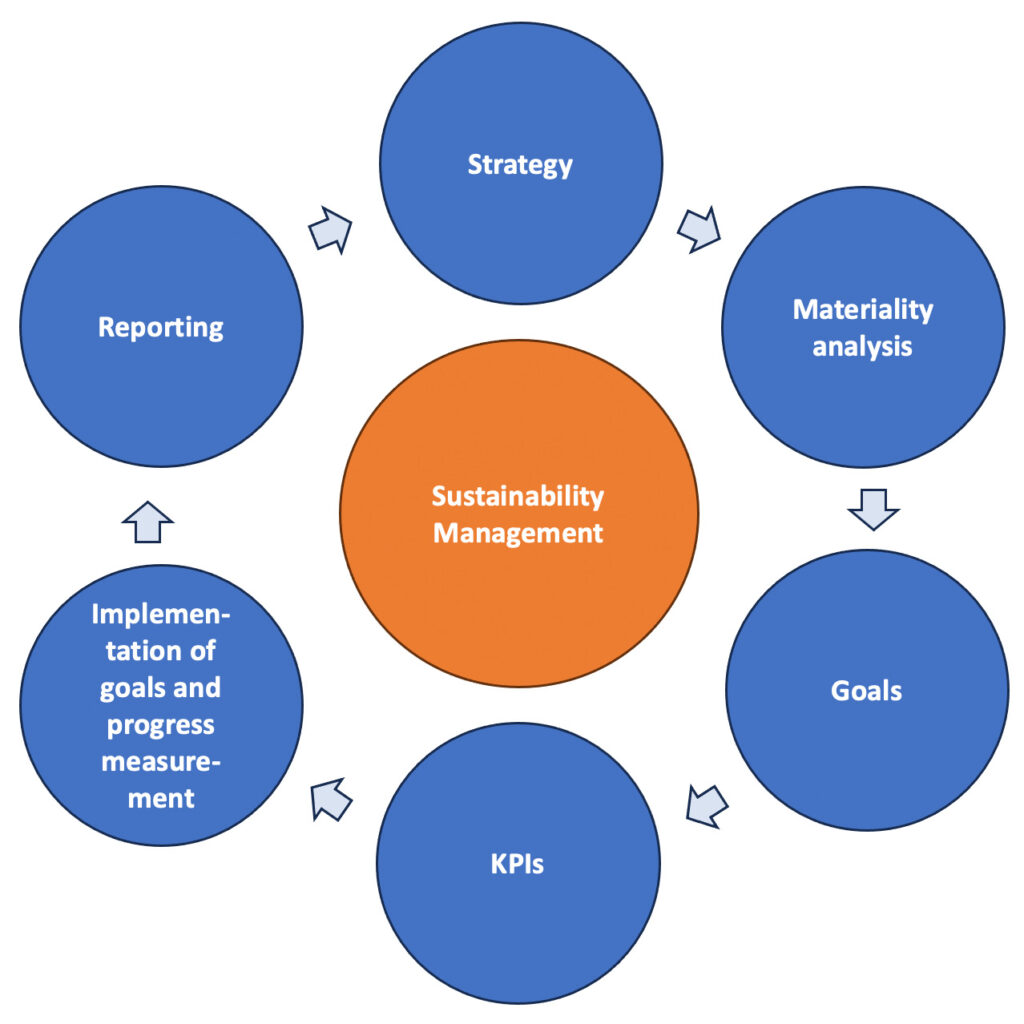Why Sustainability Management?
The increasing pressure from legislators and the rapidly growing public interest in the topic of sustainability is forcing companies to take a closer look at how their activities affect the environment and society. And, a sustainable corporate management is increasingly becoming a selection criterion for partners and suppliers. If companies cannot demonstrate active sustainability management, sooner or later they will no longer be competitive. This not only affects large companies, but also SMEs, as the demands are passed on to all companies via the supply chain. Sustainability management has gone from being a “nice to have” to a “must have”!
In addition, the capital market is currently transforming itself towards sustainability. Sustainable corporate governance leads to an improvement in the ESG rating due to CSRD and the EU Taxonomy, which in turn improves access to capital. In other words, this means that the ESG ranking on the capital market will in future be on a par with the credit rating ranking. And it looks like this will not only apply to large companies, but to all companies. Here you will also find an interview with Dipl.-Ing. Hans Kitzweger, led at the FH Technikum Wien on the topic of “ESG”. Among other things, he provides information about the background to the ESG trend and why more or less all companies will soon have to consider and optimize their ESG performance.
What does active Sustainability Management mean in concrete terms?
Sustainability Management, also known as CSR Management (Corporate Social Responsibility) or ESG Management (Environmental, Social, Governance), aims to harmonize ecological and social responsibility with economic goals. The resulting requirements are complex and require a transformation process in most companies. In addition, the following regulatory and customer-related requirements already exist or will exist in the foreseeable future, which must be taken into account as part of a Sustainability Management System.
Sustainability Management – regulatory and customer-related requirements
When setting up a sustainability management system, the ISO 26000 and ONR 192500 standards can be used as a guide, for example. The SDGs (17 Sustainable Development Goals of the United Nations – UN) can also be used as a basis.
The 9 steps to establishing active Sustainability Management
We set up your Sustainability Management System in the following 9 steps:
1.
As-is analysis, determination of legal requirements
Analysis of existing measures, applicable legal regulations, other stakeholder requirements, internal CSR requirements and CSR risks.
2.
Stakeholder and materiality analysis
A “double materiality check” is carried out based on the requirements of the CSRD.
The stakeholder and materiality analysis serves as the basis for the development of the sustainability strategy.
3.
Sustainability strategy
Developing the strategy with the company management and, if necessary, adapting existing corporate strategies and business models accordingly.
4.
Action plan Implementation of legal requirements
If there are no concrete implementation plans for the legal requirements yet, these will be drawn up and their implementation started. When applying the CSDDD, determining the relevant requirements for supply chain management.
5.
Sustainability goals
Development of sustainability targets and start of target implementation. Existing objectives from other management systems (e.g. environment, occupational safety, energy, quality) are taken into account.
6.
KPIs
Development of key figures that are based on the SDGs or GRI, for example.
7.
Structural and process organization
Definition of responsibilities, competencies and regulation of the relevant processes; if necessary, integration of the system into an existing management system.
9.
Progress evaluation
Regular evaluation of progress in sustainability management and definition of responsibilities, competencies and regulation of the relevant processes; integration of the system into an existing management system if necessary.
How else we can support you
In addition to the development and implementation of sustainability management in the 9 steps outlined above, we are also happy to support you with our many years of experience in the areas of Sustainability Management, Management Systems, CO2 Management, Legal Compliance and as Environmental Auditors in the following areas:
Our offer
We are happy to support you in setting up your Sustainability Management System.
With our many years of experience in the areas of Sustainability Management, Management Systems, CO2 Management, Legal Compliance and as Environmental Auditors, we are the ideal partner for you.



